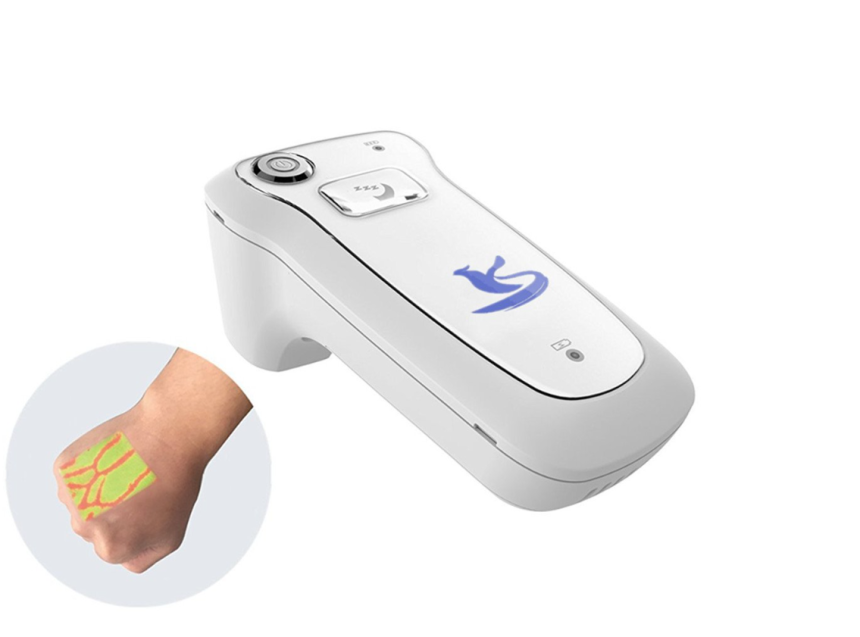If you’ve ever had to give blood, you know that finding a vein can be tricky. Especially if the person’s veins are hidden deep beneath layers of skin and muscle. But never fear!
A vein finder can help locate those pesky veins so the process of venipuncture is a breeze. Let’s take a look at how vein finders work and how they make the procedures like venipunctures and blood draws a lot more easier.
Introducing the vein finder and how it works
Veins are an important part of the human body. They carry blood and other fluids from one part of the body to another. However, veins can also be difficult to see, especially if they are located deep beneath the skin.
That’s where the vein finder comes in. A vein finder is a handheld device that uses infrared light to detect veins. To use it, simply hold it against the skin and move it around until the veins become visible. The vein finder is especially useful for doctors and nurses who need to quickly and accurately locate veins for IVs or blood tests. It’s also great for people with conditions that make their veins difficult to see, such as diabetes.
So how does it work? The answer is actually quite simple. The infrared light emitted by the vein finder is able to penetrate the skin and reflect off of the blood vessels beneath. This reflection is then captured by a sensor in the device and displayed on a screen, making the veins appear bright and easy to see. If you’re looking for a quick and easy way to locate your veins, the vein finder is a great option. It’s portable, easy to use, and can be a lifesaver in a pinch.
Locating veins for venipuncture – practical tips
If you’re a nurse, one of the most important skills you will learn is venipuncture: the act of drawing blood from a vein. While this may seem like a straightforward task, finding a suitable vein can sometimes be a challenge. Here are a few practical tips to help you locate veins for venipuncture:
1. Look for veins that are close to the surface of the skin and have a smooth, round shape. Avoid veins that are visible only when the patient clenches their fist or that appear to be collapsed.
2. Feel for veins that are firm and full. A good way to test this is to gently press on the skin above the vein with your thumb. If the vein rebounds quickly, it is likely to be suitable for venipuncture.
3. If you are having trouble finding a suitable vein, try using a tourniquet. This will cause the veins in the affected area to swell and become more prominent. Be sure to release the tourniquet periodically to avoid causing discomfort to the patient.
With these tips in mind, you should be able to locate veins for venipuncture with ease. Remember, practice makes perfect!
The benefits of using a vein finder
Studies have shown that vein finders can improve the success rate of venipuncture and decrease the number of needle sticks required. In addition, vein finders can help to reduce the pain and anxiety associated with the procedure.
For patients, this means a quicker, more comfortable experience. For medical professionals, it means fewer unsuccessful attempts and less need for repeated sticks. Ultimately, vein finders can benefit both patients and providers by making venipuncture easier and more efficient.
How to use a vein finder for venipuncture
While traditional methods for finding veins can be time-consuming and often result in multiple failed attempts, vein finders offer a quick and easy solution with a high success rate. Here’s how to use one:
1. Clean the area where you will be inserting the needle with an alcohol swab. This will help to prevent infection.
2. Place the vein finder over the area you wish to insert the needle. The device will emit a red light, which will reflect off of the veins under your skin and make them visible.
3. Once you have located a suitable vein, insert the needle into the vein and proceed with your venipuncture procedure.
With a little practice, using a vein finder can become second nature – and it just might make your next venipuncture experience a little less daunting!
FAQs about vein finders
Q: What is a vein finder?
A: A vein finder is a handheld device that uses infrared light to make veins visible beneath the skin. This can be helpful when performing venipuncture, as it allows medical professionals to quickly and accurately locate veins.
Q: How does a vein finder work?
A: The vein finder emits a beam of infrared light, which penetrates the skin and reflects off of the blood vessels beneath. This reflection is then captured by a sensor in the device and displayed on a screen, making the veins appear bright and easy to see.
Q: Are there any risks associated with using a vein finder?
A: No, there are no known risks associated with using a vein finder. The infrared light used by the device is safe and will not cause any damage to the skin or tissue.
Q: How do I choose a vein finder?
A: When selecting a vein finder, it is important to consider the features that are most important to you. Some factors you may want to consider include the size of the device, the battery life, and the display resolution.
Q: How to make sure I’m using my vein finder correctly?
A: If you’re unsure about how to use your vein finder, we recommend consulting the user manual or contact the manufacturer for assistance. Additionally, there are many helpful tutorial videos available online that can walk you through the process step-by-step.
The Bottom Line
A vein finder can be a valuable tool for medical professionals and patients alike when it comes to locating difficult veins. By understanding how these devices work and the benefits they offer, you can make an informed decision about whether or not one is right for you. Have you ever used a vein finder? If so, we’d love to hear about your experience in the comments below!















